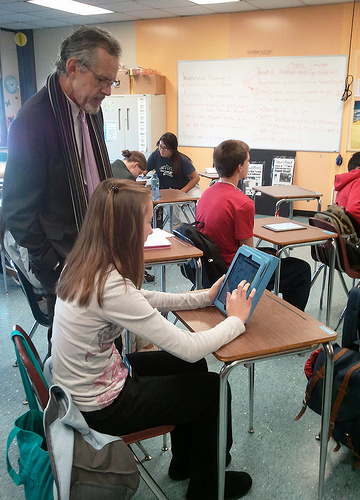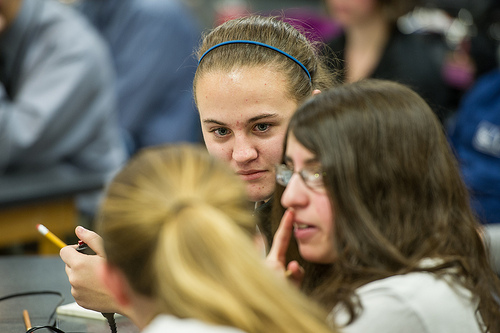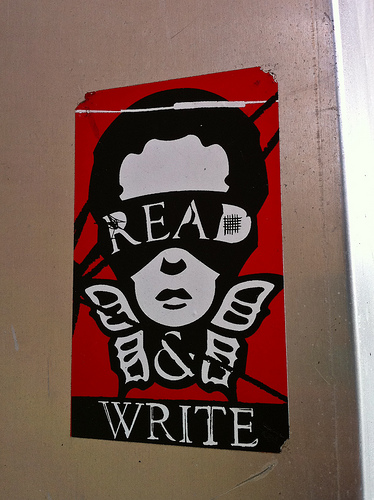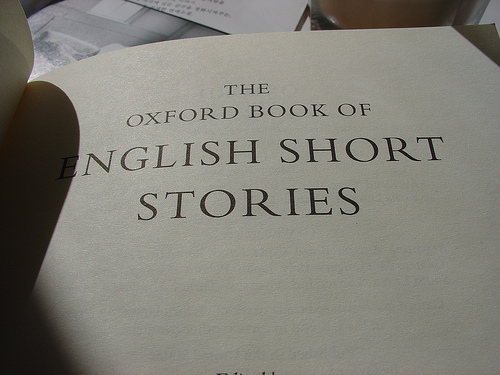
Source: Revere High School Visit, Massachusetts
Education, Flickr
Say you are sitting in Mr. Thomas’s third period English class. It’s a Monday morning in early May, but it’s already 85 degrees outside—springtime in Texas. As you fish your notebook out of your desk, you hear your teacher’s voice from the front of the room.
“All right, before we get started on our writing lesson, I need to remind you about the timed writing exercise scheduled for Friday.”
You exchange shocked looks with your friend across the aisle. Swallowing hard, you blurt out, “What exercise? We don’t know about any exercise this week.” Turning to your friend for support, you begin saying, “You didn’t tell us . . .”
Before you can finish, Mr. Thomas answers. “Now I know to some of you this might come as a bit of a shock,” he says. Looking in your direction, he continues. “This is not a surprise,” he says. “In fact, you might say we’ve been preparing for this writing exercise since the holiday break. Besides, this exercise is for practice. Maybe you can have some fun with it.”
“Oh, that,” you say, relaxing a bit. “Now I remember. Short stories, right?”

Source: High School Science Bowl, National Renewable Energy
Laboratory, Flickr
Mr. Thomas nods, smiling benevolently. “That’s right, Robert. Short stories, the things we’ve been reading, studying, and writing since the holidays. Now it’s time to try one on your own. You’ll need to remember everything we have talked about in terms of planning, organization, and writing. But that shouldn’t be a problem. You have all done so well on literary text reading and writing up to now that it’ll be as easy as taking a dip in Barton Springs and twice as satisfying!”
You and your friend roll your eyes.
“He always says something cheesy like that,” your friend says.
You let out a heavy sigh. “Yeah, it makes you wonder if he’s ever been to the Springs!”
Although this story is presented as a piece of fiction (maybe you don’t have English class third period, and you don’t know a Mr. Thomas), what if it the part about having to write an in-class, timed short story was true? Would you be able to complete the task successfully?
If you’re unsure, you can relax because that’s what this lesson is about: how to write a short story within time and writing space limitations using proper organization, believable characters, an engaging plot, proper point of view, and a vivid setting. We will return to the scene above later in this lesson.
A Word about the Reading/Writing Connection

Source: Red Write, Imelda, Flickr
You know that reading and writing are connected, and you probably know that you can analyze how authors achieve their purpose, and then use this knowledge to inform your own writing. This connection is one reason writers study literature: to appreciate and imitate it. The same is true when considering short story writing. How does this connection relate to the focus of this lesson?
Simply put, if you have studied the methods of successful writers, you will find it easier to write a short story within time and writing space limitations. Also, when you encounter a writing prompt for a short story, you will be able to access certain elements, methods, and techniques you have studied.
This lesson focuses specifically on how to create a work of fiction within a short period of time and limited writing space. Our consideration of various authors’ texts will be limited to how the authors use elements to achieve their purpose.
Short x 3 (short story, short space, short time)

Source: The Oxford Book of English Short Stories, dlacrose, Flickr
The literary components of short stories include plot, characters, setting, point of view, and theme. For in depth study on these components you may want to review Writing an Engaging Short Story with Well-Developed Conflict and Resolution, Writing an Engaging Short Story with Interesting and Believable Characters, and Writing an Engaging Story with Literary Strategies Including Dialogue and Suspense to Enhance Plot. This lesson is about how to integrate these elements into an engaging story on the spur of the moment.
Writing a short story is an act of creation. Even though you may take certain elements of your story from real life, you are, in fact, making it up as you go along. As you can imagine, this act of creation takes not only a solid understanding of the elements of a good short story, but also knowledge about how to plan, organize, and write it—all within time and writing space limitations. If this task seems daunting, rest easy; you may find that writing a short story under these circumstances is not only possible, but enjoyable. You only need to do a little preplanning, thinking, and feeling ahead of time.
As Mr. Thomas suggests in the opening scenario, writing a short story can be fun. Watch this video to see how writers in Peru turned writing a short story into a spectator sport.